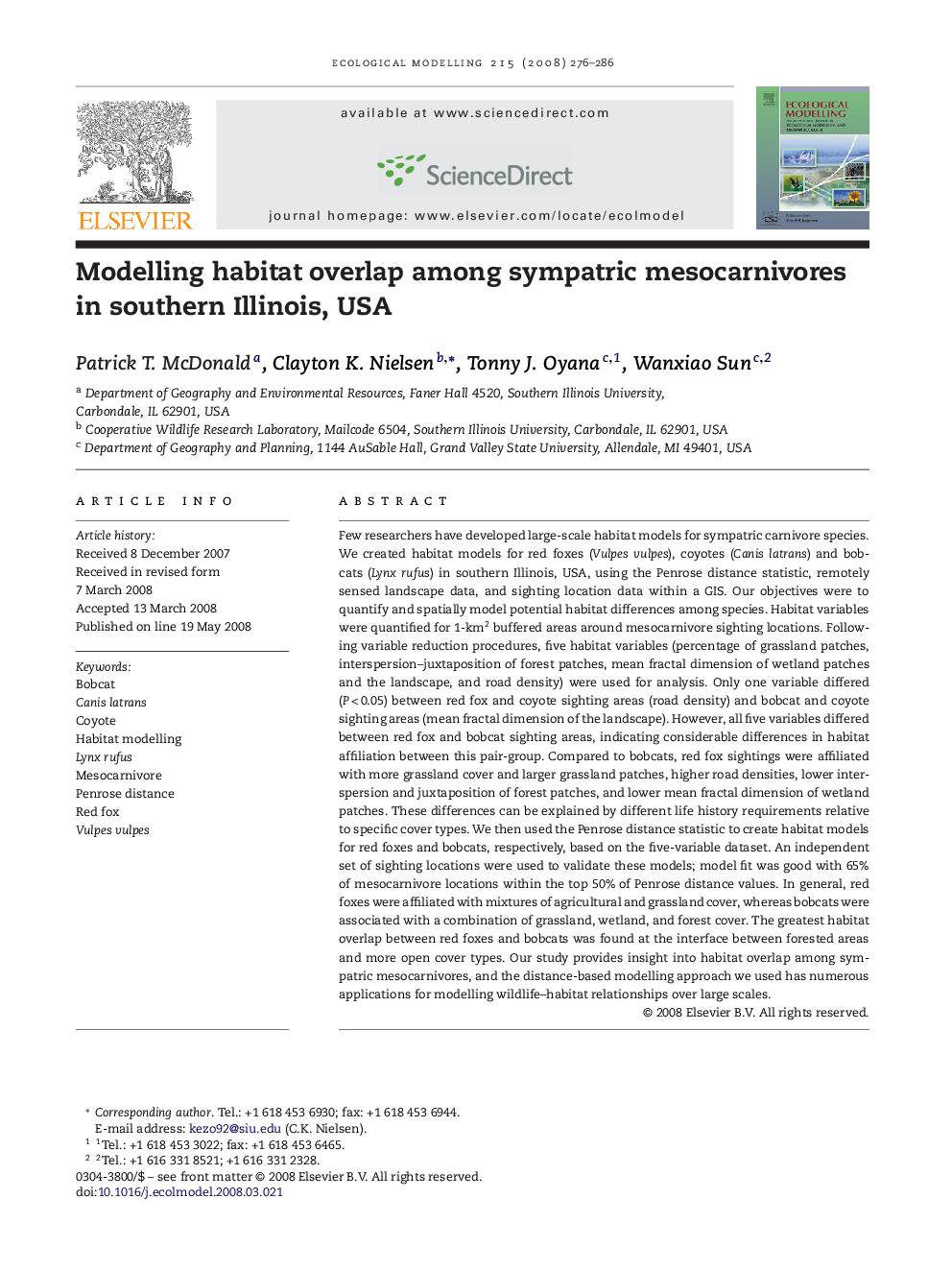| کد مقاله | کد نشریه | سال انتشار | مقاله انگلیسی | نسخه تمام متن |
|---|---|---|---|---|
| 4377936 | 1303454 | 2008 | 11 صفحه PDF | دانلود رایگان |
عنوان انگلیسی مقاله ISI
Modelling habitat overlap among sympatric mesocarnivores in southern Illinois, USA
دانلود مقاله + سفارش ترجمه
دانلود مقاله ISI انگلیسی
رایگان برای ایرانیان
کلمات کلیدی
موضوعات مرتبط
علوم زیستی و بیوفناوری
علوم کشاورزی و بیولوژیک
بوم شناسی، تکامل، رفتار و سامانه شناسی
پیش نمایش صفحه اول مقاله

چکیده انگلیسی
Few researchers have developed large-scale habitat models for sympatric carnivore species. We created habitat models for red foxes (Vulpes vulpes), coyotes (Canis latrans) and bobcats (Lynx rufus) in southern Illinois, USA, using the Penrose distance statistic, remotely sensed landscape data, and sighting location data within a GIS. Our objectives were to quantify and spatially model potential habitat differences among species. Habitat variables were quantified for 1-km2 buffered areas around mesocarnivore sighting locations. Following variable reduction procedures, five habitat variables (percentage of grassland patches, interspersion-juxtaposition of forest patches, mean fractal dimension of wetland patches and the landscape, and road density) were used for analysis. Only one variable differed (PÂ <Â 0.05) between red fox and coyote sighting areas (road density) and bobcat and coyote sighting areas (mean fractal dimension of the landscape). However, all five variables differed between red fox and bobcat sighting areas, indicating considerable differences in habitat affiliation between this pair-group. Compared to bobcats, red fox sightings were affiliated with more grassland cover and larger grassland patches, higher road densities, lower interspersion and juxtaposition of forest patches, and lower mean fractal dimension of wetland patches. These differences can be explained by different life history requirements relative to specific cover types. We then used the Penrose distance statistic to create habitat models for red foxes and bobcats, respectively, based on the five-variable dataset. An independent set of sighting locations were used to validate these models; model fit was good with 65% of mesocarnivore locations within the top 50% of Penrose distance values. In general, red foxes were affiliated with mixtures of agricultural and grassland cover, whereas bobcats were associated with a combination of grassland, wetland, and forest cover. The greatest habitat overlap between red foxes and bobcats was found at the interface between forested areas and more open cover types. Our study provides insight into habitat overlap among sympatric mesocarnivores, and the distance-based modelling approach we used has numerous applications for modelling wildlife-habitat relationships over large scales.
ناشر
Database: Elsevier - ScienceDirect (ساینس دایرکت)
Journal: Ecological Modelling - Volume 215, Issue 4, 24 July 2008, Pages 276-286
Journal: Ecological Modelling - Volume 215, Issue 4, 24 July 2008, Pages 276-286
نویسندگان
Patrick T. McDonald, Clayton K. Nielsen, Tonny J. Oyana, Wanxiao Sun,